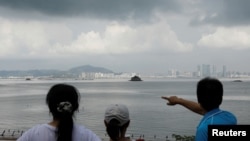Peggy Lee and her high school classmate, Lin Chiao-yin, screamed in pleasure this week on a shaded cliff along a sun-soaked beach on the Taiwanese island of Kinmen as they practiced street dancing and chatted about the hottest tunes. Sixteen year old Lin was taking a break from tending to her father’s beachside café.
An expired military tank sat right below them on the beach, and 15 kilometers beyond that loomed the easily visible high-rise skyline of Xiamen, a major city in southeastern China. The café operates on the roof of a camouflage-painted army fortress that once scanned the sea for Chinese artillery, but Lee and Lin weren’t scared.
“We find it pretty over there, but there’s actually no sense of distance,” Lin said, gesturing toward China. “That’s because we’re used to it.”
These classmates reflect views common among the 127,000 people of Kinmen County, a jurisdiction covering the two inhabited Taiwanese-held islets closest to Taiwan's old military rival China.
People on the once heavily militarized islands now dominated by rustic farmhouses and quiet national park land see China every day as a source of tourism, fresh water and a transit point for Taiwanese investors.
Kinmen’s denizens are following the recent plummet in relations between Taipei and Beijing, which has not renounced the threat of force to capture Taiwan, if needed. However, their proximity leaves the impression of a static relationship, even a cooperative one, rather than a threat.
“Exchanges between the two sides would continue if not for the pandemic and the average citizen here feels that we’re all very peaceful. You come here, I go over there, that’s good for all,” said 80-year-old Kinmen snack seller Tung Shui-lun, a defense squad member during the fighting with China in the 1950s over two islands, Quemoy and Matsu.
“We can’t manage a country’s major affairs, so we have no way of understanding whether they want to attack us,” Tung said.
Old tanks and other military gear scattered along the Kinmen coastlines hearken back to the 1950s when China shelled the islands in a bid to take them. Now they draw tourists, and about 400,000 Chinese travelers ferried over from Xiamen in 2018 following steady increases in visitors from China that had occurred since 2011. Taiwan suspended the ferry link last year to keep COVID-19 out.
About 1.5 million others, mainly Taiwanese investors with business in China, took ferries the other way after flying in from the major Taiwanese island through Kinmen’s busy airport.
Taiwan’s National Defense Ministry does not disclose the number of troops still in Kinmen County, but locals estimate 3,000 – down from tens of thousands in the past. Weather-worn beach lookouts today either sit empty or form the foundation for military history museums.
Beijing’s communist leadership has called Taiwan its own since the Chinese civil war of the 1940s, when Chiang Kai-shek’s Nationalists lost to Mao Zedong’s forces and fled to Taipei and set the stage for the shelling of Kinmen. Most Taiwanese said in government surveys two years ago they oppose unification with modern China.
Taiwanese President Tsai Ing-wen supports that sentiment and the two sides quit formal talks in 2016 after Tsai took office. To pressure her government and warn Taiwan’s staunch informal ally the United States, China passes military aircraft through Taiwan’s air defense identification zone almost daily with an unusually large showing January 24, days after U.S. President Joe Biden took office.
“We care a lot of course about the news happening now, and because of that concern we expect that the two sides can discuss things openly and that each side will respect the other’s views,” Kinmen County’s Deputy Magistrate Hwang Yi-kai said, adding that Kinmen’s experience with war gives people these views.
“We believe that dialogue and communication are necessary," he said.
The two second-year high school classmates, though, one a Kinmen native and the other having lived in the county since age 5, are used to meeting Chinese tourists during non-COVID years and drinking water imported from China. Taiwan and China signed a deal in 2015 to provide Kinmen with an average of 34,000 tons of water per day for 30 years.
They listen to dance cuts on TikTok, a music sharing service owned by Beijing-based tech firm ByteDance.
A lot of Kinmen people identify culturally with China’s Fujian province, which is the one closest to their islands, and do not always see themselves as Taiwanese, 19-year-old transplant Shen Pei-ju has found after four months. The biggest waves of migration to Taiwan began in Fujjian several hundred years ago.
People in Taiwan, especially in Shen’s age range, often see themselves today as Taiwanese rather than Chinese. That identity partly reflects anger over Beijing’s claims that both sides fall under the same flag and should unify.
“I think nowadays Taiwanese people are saying ‘we’re Taiwan’, but Kinmen people will think they’re not,” Shen said.










